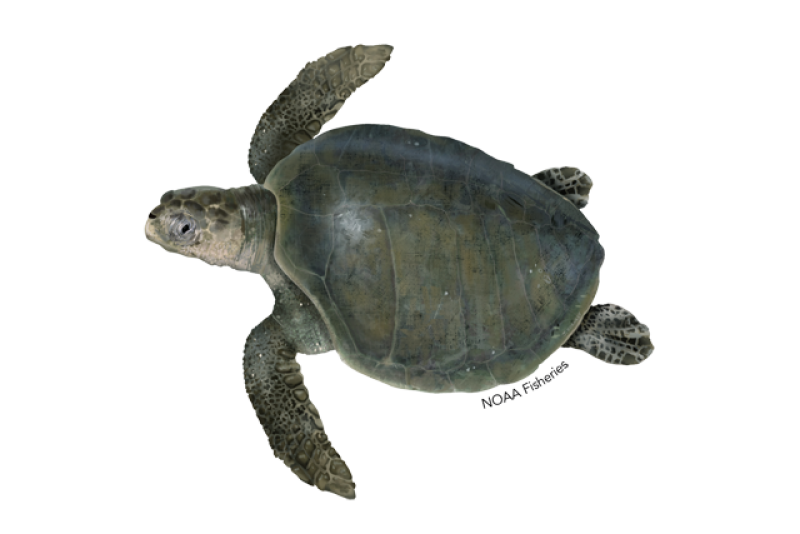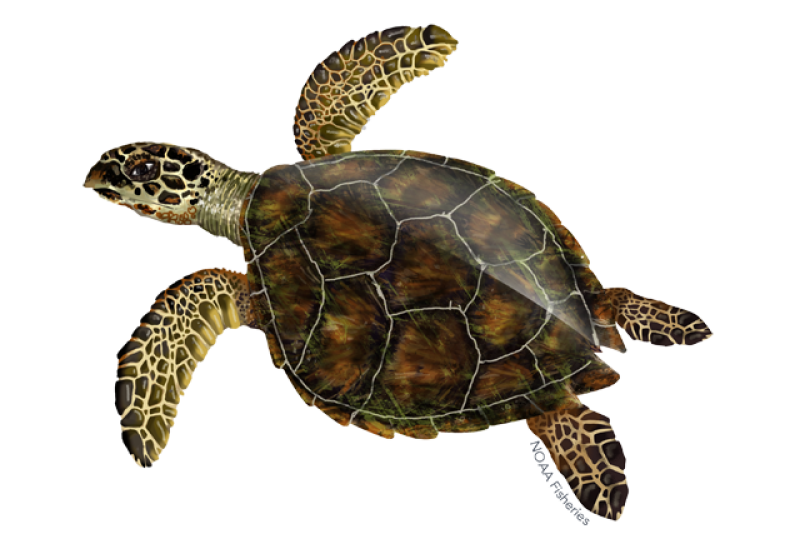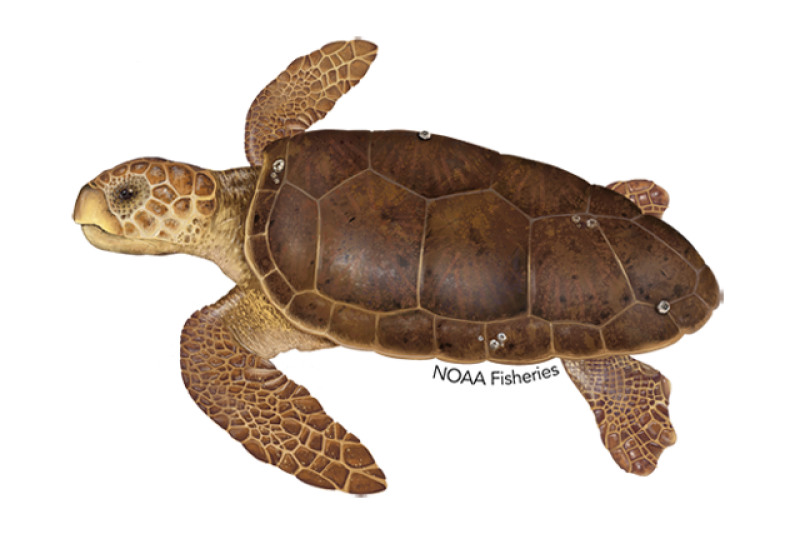Kemp's Ridley Turtle
Lepidochelys kempii
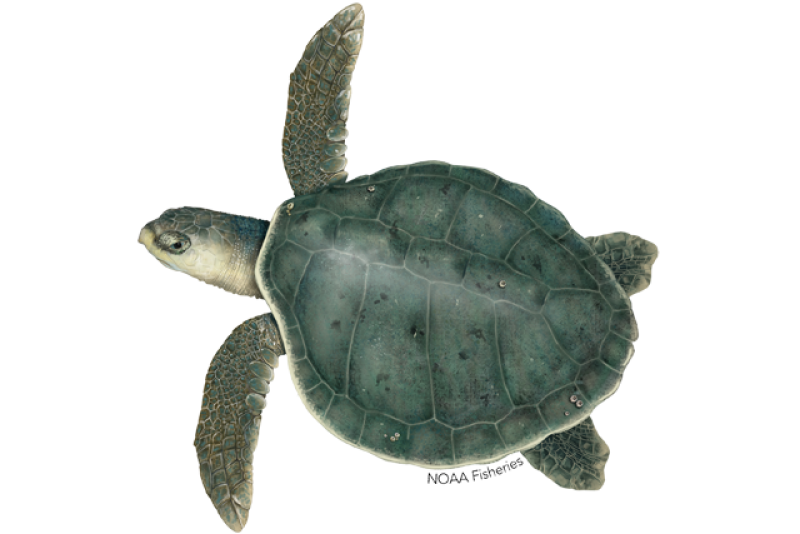
Protected Status
Quick Facts
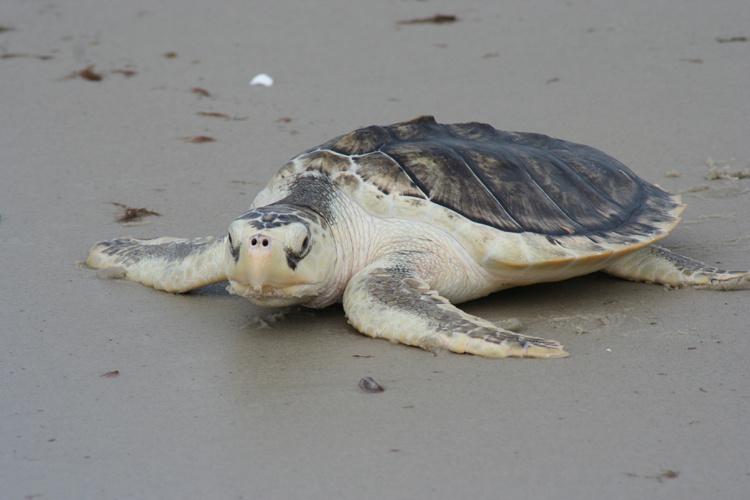 A Kemp's Ridley sea turtle on the beach - Credit: Kate Sampson, NOAA Fisheries
A Kemp's Ridley sea turtle on the beach - Credit: Kate Sampson, NOAA Fisheries
A Kemp's Ridley sea turtle on the beach - Credit: Kate Sampson, NOAA Fisheries
About the Species
 A Kemp's Ridley sea turtle on the beach - Credit: Kate Sampson, NOAA Fisheries
A Kemp's Ridley sea turtle on the beach - Credit: Kate Sampson, NOAA Fisheries
A Kemp's Ridley sea turtle on the beach - Credit: Kate Sampson, NOAA Fisheries
Kemp’s ridley sea turtles are the smallest sea turtle in the world. The species is named after Richard M. Kemp, a fisherman from Key West, Florida, who first submitted the species for identification in 1906. They are primarily found in the Gulf of America (formerly Gulf of Mexico), but juveniles are also found in the Atlantic Ocean as far north as Nova Scotia and sometimes even occur in the eastern North Atlantic Ocean.
Kemp’s ridleys were once abundant in the Gulf of America with tens of thousands of females nesting at Rancho Nuevo, Mexico. The population crashed in the mid-20th century to a low of only several hundred females nesting (representing fewer than 250 nests) in the 1980s. Intensive conservation actions were implemented on nesting beaches and through fisheries management. Bycatch in commercial and recreational fishing gear continues to be the biggest threat facing Kemp’s ridley sea turtles.
NOAA Fisheries and our partners are dedicated to protecting and recovering the Kemp’s ridley sea turtle. We use a variety of innovative techniques to study, protect, and recover this endangered species. We engage our partners as we develop measures and implement recovery plans that foster the conservation and recovery of Kemp’s ridleys and their habitats, and we fund research, monitoring, and conservation projects to implement priorities outlined in recovery plans.
Population Status
The Kemp’s ridley turtle is listed as endangered under the Endangered Species Act. Prior to the mid-20th century, the Kemp's ridley was abundant in the Gulf of America. An amateur video from 1947 documented tens of thousands of Kemp’s ridleys nesting near Rancho Nuevo, Mexico on a single day. This nesting population experienced a devastating decline between the late 1940s and the mid-1980s. The number of nests reached a record low of 702 in 1985, representing fewer than 250 nesting females. Due to intensive conservation actions, the Kemp's ridley began to slowly rebound during the 1990s. The number of nests increased about 15 percent each year through 2009. However, in 2010 this rapid increase abruptly ended and the number of nests has fluctuated since then. The unexpected change in Kemp’s ridley nesting highlights the importance of continued protection, monitoring, and conservation efforts.
The majority of Kemp’s ridley nesting occurs on the beaches of the western Gulf and ninety-five percent of worldwide Kemp’s ridley nesting occurs in the state of Tamaulipas, Mexico. The three main nesting beaches in Tamaulipas are Rancho Nuevo, Tepehuajes, and Barra del Tordo. Nesting also occurs in Veracruz, Mexico, and in Texas, but on a much smaller scale. Occasional nesting has been documented in North Carolina, South Carolina, Georgia, Florida, and Alabama.
The 2015 ESA 5-year review of the Kemp's ridley sea turtle provides additional information on abundance and population trends.
Appearance
The Kemp's ridley turtle has a triangular-shaped head with a slightly hooked beak. Hatchlings are darkly colored on both sides. Adults are generally a grayish-green color on top with a pale, yellowish bottom shell. The top shell (carapace) is often as wide as it is long. Each of the front flippers has one claw while the back flippers may have one or two.
Behavior and Diet
Kemp’s ridley turtles, like all sea turtles, are marine reptiles and must come to the surface to breathe. Adult female sea turtles return to land to lay their eggs in the sand—they are remarkable navigators and usually return to a beach in the general area where they hatched decades earlier.
The Kemp's ridley is one of two species of sea turtles that engage in "arribada" nesting, where large groups of females gather offshore and come onto the beach to nest all at once. Nesting in large groups may be a defense against predators, or a result of environmental factors influencing nesting. With many turtles coming ashore together and many nests subsequently hatching at the same time, the large numbers of hatchlings entering the ocean may help to overwhelm predators and ensure that more hatchlings survive. The other species of sea turtle that nests en masse is the olive ridley. The Kemp’s ridley is the only species of sea turtle that routinely nests during the day.
After emerging from the nest, hatchlings enter the water and swim rapidly offshore. Some hatchlings remain in currents within the Gulf of America while others may be swept out of the Gulf, around Florida, and into the Atlantic Ocean by the Gulf Stream. Juvenile Kemp’s ridleys associate with floating Sargassum algae, using the Sargassum as an area of refuge, rest, and a place to feed on small animals and plants. This developmental drifting period lasts 1 to 2 years or until the turtle reaches a length of about 8 inches. After this oceanic phase, Kemp’s ridleys migrate to nearshore areas of the Gulf of America or northwestern Atlantic Ocean. After recruiting to shallow coastal areas, crabs are their preferred food.
Depending on their breeding strategy, male Kemp's ridleys occupy many different areas within the Gulf of America. Some males migrate annually between feeding and breeding grounds, yet others may not migrate at all, mating with females encountered at their feeding grounds or near nesting beaches. Female Kemp's ridleys have been tracked migrating to and from nesting beaches in Mexico and south Texas. Females leave breeding and nesting areas and migrate to foraging areas ranging from the Yucatán Peninsula to southern Florida to the north-central Gulf of America. Some females take up residence in specific foraging grounds for months at a time and return to the same foraging grounds in subsequent years.
Where They Live
Kemp's ridleys are distributed throughout the Gulf of America and U.S. Atlantic seaboard, from Florida to New England. A few records exist for Kemp's ridleys in Canada, near the Azores, the United Kingdom, waters off Morocco, and within the Mediterranean Sea and they are occasionally found in other areas around the Atlantic Basin. Adult Kemp's ridleys primarily occupy nearshore coastal (neritic) habitats in the Gulf of America that include muddy or sandy bottoms where their preferred prey are found.
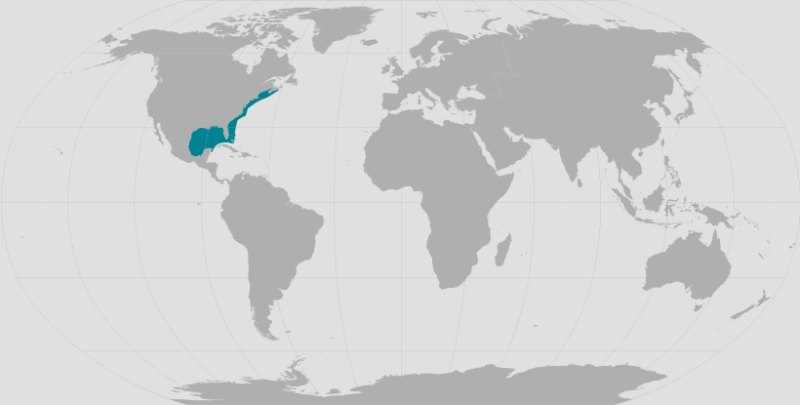 World map providing approximate representation of the Kemp's ridley turtle's range.
World map providing approximate representation of the Kemp's ridley turtle's range.
Lifespan & Reproduction
No one knows exactly how long Kemp’s ridleys live, but like other sea turtles, they are likely long-lived, reaching maturity at about 13 years of age and have an estimated lifespan of at least 30 years.
Kemp's ridleys display one of the most unique synchronized nesting habits in the natural world. Adult female Kemp's ridleys gather off nesting beaches in northeastern Mexico and come ashore in large groups, called arribadas, which means "arrival" in Spanish. There are many theories on what triggers an arribada, including offshore winds, lunar cycles, and the release of pheromones by females. However, scientists have yet to conclusively determine what triggers an arribada. Arribada nesting is a behavior found only in the genus Lepidochelys which includes the olive ridley sea turtle (Lepidochelys olivacea) and Kemp’s ridley.
Nesting occurs from April to July and unlike the other species which nest at night, Kemp’s ridleys nest during daylight hours. They lay an average of 2 to 3 clutches per season, and return to the beach to nest every 1 to 3 years. The females dig an egg chamber in the sand where they lay approximately 100 eggs, which incubate for 50 to 60 days. Hatchlings orient seaward by moving away from the darkest silhouette of the landward dune or vegetation to crawl towards the brightest horizon. On undeveloped beaches, this is toward the open horizon over the ocean.
Threats
Bycatch in Fishing Gear
A primary threat to sea turtles is their unintended capture in fishing gear which can result in drowning or cause injuries that lead to death or debilitation (for example, swallowing hooks, or flipper entanglement). The term for this unintended capture is bycatch. Sea turtle bycatch is a worldwide problem. Kemp’s ridleys are primarily caught in trawls, gillnets, longlines, hook and lines, pot/traps, and dredges in the Gulf of America and northwest Atlantic.
Direct Harvest of Turtles and Eggs
Almost the entire Kemp’s ridley sea turtle population nests on the beaches of the western Gulf, primarily in Tamaulipas, Mexico, just south of the United States-Mexico border. The arribada nesting behavior concentrates females and nests at the same time and in the same place, enabling the taking of an extraordinary number of eggs for human consumption. Historically, egg collection for human consumption was a significant problem in this area, but this threat has been diminished by the protection of nests and turtles in both Mexico and the United States.
Loss and Degradation of Nesting Habitat
Coastal development and rising seas are leading to the loss of nesting beach habitat for sea turtles. Human-related changes associated with coastal development include beachfront lighting, shoreline armoring, and beach driving. Shoreline hardening or armoring (e.g., seawalls) can result in the complete loss of dry sand suitable for successful nesting. Artificial lighting on and near nesting beaches can deter nesting females from coming ashore to nest and can disorient hatchlings trying to find the sea after emerging from their nests.
For Kemp’s ridleys, beach driving is a threat to the turtles and the nesting habitat. Driving on nesting beaches can injure or kill nesting turtles, eggs, and hatchlings. Nesting turtles can be difficult to see and they cannot move quickly on land to avoid an approaching vehicle. Beach driving also degrades the nesting habitat by causing sand compaction and creating ruts and ridges in the sand that pose obstacles to nesting turtles and hatchlings attempting to reach the ocean, resulting in an extended period of travel or entrapment.
Predation of Eggs and Hatchlings
The destruction and consumption of eggs and hatchlings by non-native and native predators, such as feral pigs, coyotes, raccoons, birds, and crabs is a threat to Kemp’s ridley sea turtles. Predation control is an effective tool to reduce this threat and improve in situ hatching success.
Vessel Strikes
Various types of watercraft can strike sea turtles when they are at or near the surface, resulting in injury or death. Vessel strikes are a threat to sea turtles near ports, waterways, and along developed coastlines throughout their range. High boat traffic areas such as marinas, boat ramps, and inlets present a higher risk. Adult sea turtles, in particular nesting females, are more susceptible to vessel strikes when making reproductive migrations and while they are nearshore during the nesting season or if they reside in coastal foraging habitats that may overlap in areas with high boat traffic.
Ocean Pollution/Marine Debris
Increasing pollution of nearshore and offshore marine habitats threatens all sea turtles and degrades their habitats. The Deepwater Horizon oil spill was the largest offshore oil spill in U.S. history and affected nesting (including nesting females, eggs, and hatchlings), small juvenile, large juvenile, and adult sea turtles throughout the Gulf of America. Ingestion of marine debris is another threat to all species of sea turtles. Kemp’s ridley turtles may ingest fishing line, balloons, plastic bags, plastic fragments, floating tar or oil, and other materials discarded by humans which they can mistake for food. They may also become entangled in marine debris, including lost or discarded fishing gear, which can lead to injury or death.
Changing Environmental Conditions
For all sea turtles, higher sand temperatures can be lethal to eggs or alter the ratio of male and female hatchlings produced (via temperature-dependent sex determination). Rising seas and storm events change beach morphology and cause beach erosion, which may flood nests or wash them away. Changes in the temperature of the marine environment are likely to alter habitat suitability, as well as the abundance and distribution of food resources, leading to a shift in the migratory and foraging range and nesting season of Kemp's ridleys. Environmental conditions also can cause large sea turtle stranding events during the winter months along the northeast coast of the U.S..
Scientific Classification
| Kingdom | Animalia | Phylum | Chordata | Class | Reptilia | Order | Testudines | Family | Cheloniidae | Genus | Lepidochelys | Species | kempii |
|---|
Last updated by NOAA Fisheries on 05/29/2025
What We Do
Conservation & Management
Since 1977, NOAA Fisheries and the U.S. Fish and Wildlife Service (FWS) have shared jurisdiction of sea turtles under the ESA. A Memorandum of Understanding outlines our specific roles: NOAA Fisheries leads the conservation and recovery for sea turtles in the marine environment, and the U.S. FWS leads the conservation and recovery efforts for sea turtles on nesting beaches.
We are committed to the protection and conservation of Kemp’s ridley turtles by:
- Working with partners to ensure compliance with national, state, and U.S. territory laws to protect sea turtles and their habitats
- Cooperating with international partners to implement conservation measures supported by international treaties that protect sea turtles
- Researching, developing, and implementing changes to fishing gear practices and/or fishing gear modifications (e.g., turtle excluder devices for trawl fisheries, using large circle hooks in longline fisheries), and implementing spatial or temporal closures to avoid or minimize bycatch
- Protecting and monitoring Kemp’s ridleys in the marine environment and on nesting beaches
- Conducting research on threats and developing conservation measures that reduce threats and promote recovery, and on the species biology and ecology to better inform conservation management strategies and to assess progress toward recovery
- Conducting and supporting education and outreach efforts to the general public by raising awareness on threats to sea turtles, highlighting the importance of sea turtle conservation, and sharing ways people can help sea turtles
Science
We conduct various research activities on the biology, behavior, and ecology of Kemp’s ridley turtles. The results of this research are used to evaluate population trends, inform conservation management strategies, and to assess progress toward recovery for this imperiled species. Our work includes:
- Monitoring populations through vessel-based or aerial surveys, nesting beach studies, satellite tracking, genetics, and capture-mark-recapture (flipper tagging) studies
- Studying foraging and reproductive behavior to understand demographics, physiology, habitat use, and resource requirements
- Tracking individuals over time to understand important aspects of their life history such as growth and age to maturity
- Evaluating life history, demographic, and population health information from stranding and fisheries bycatch datasets
- Understanding impacts of change in environmental and ocean conditions on sea turtle abundance, distribution, and demographics
- Estimating population abundance and analyzing trends
- Monitoring fisheries impacts and working with the fishing industry to design fishing gear to minimize bycatch during commercial and recreational fishing operations
- Building capacity and training to share the latest scientific techniques and tools to monitor sea turtle populations globally
How You Can Help
Reduce Ocean Trash
Reduce marine debris and participate in coastal clean-up events. Responsibly dispose of fishing line - lost or discarded fish line kills hundreds of sea turtles and other animals every year. Trash in the environment can end up in the ocean and harm marine life.
Reduce plastic use to keep our beaches and oceans clean—carry reusable water bottles and shopping bags.
Refrain from releasing balloons—they can end up in the ocean where sea turtles can mistake them for prey like jellyfish or become entangled in lines.
Keep Your Distance
Admire sea turtles from a respectful distance by land or sea and follow these guidelines:
Don’t disturb nesting turtles, nests, or hatchlings. If interested, attend organized sea turtle watches that know how to safely observe sea turtles.
Never feed or attempt to feed or touch sea turtles as it changes their natural behavior and may make them more susceptible to harm.
Boat strikes are a serious threat to sea turtles. When boating, watch for sea turtles in the water, slow down, and steer around them. If you encounter them closer than 50 yards, put your engine in neutral to avoid injury. Remember, Go Slow, Sea Turtles Below!
Protect Sea Turtle Habitat
Beaches are paramount for healthy sea turtle populations since females come to the shore to deposit their eggs into nests.
Keep nesting beaches dark and safe at night. Turn off, shield, or redirect lights visible from the beach—lights disorient hatchlings and discourage nesting females from coming onto beaches to lay their eggs.
After a day at the beach, remove recreational beach equipment like chairs and umbrellas so sea turtles are not entrapped or turned away. Also, fill in holes and knock down sandcastles before you leave—they can become obstacles for nesting turtles or emerging hatchlings.
Do not drive on sea turtle nesting beaches—vehicles can deter females from nesting, directly strike hatchlings and nesting turtles, damage incubating nests, and create ruts that prevent hatchlings from reaching the sea.
Report Marine Life in Distress
If you see a stranded, injured, or entangled sea turtle, contact professional responders and scientists who can take appropriate action. Numerous organizations around the country are trained and ready to respond.
Learn who you should contact when you encounter a stranded or injured marine animal
Featured News
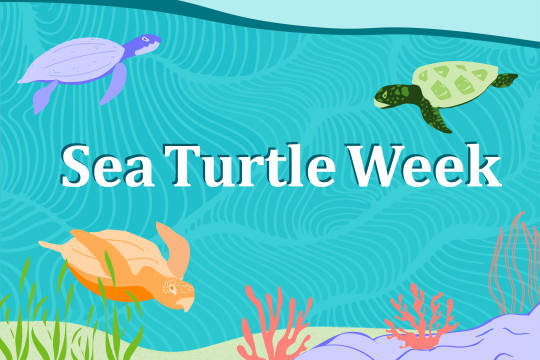
 Leatherbacks are the largest sea turtles in the world, but all major populations are rapidly declining around the world because of persistent threats on their nesting beaches and in the marine environment. Photo credit: Jason Isley/Scubazoo. Photo for NOAA Fisheries use only.
Leatherbacks are the largest sea turtles in the world, but all major populations are rapidly declining around the world because of persistent threats on their nesting beaches and in the marine environment. Photo credit: Jason Isley/Scubazoo. Photo for NOAA Fisheries use only.
 A veterinarian holds sea turtle “Betty.” Credit: NOAA Fisheries/Melissa Cook
A veterinarian holds sea turtle “Betty.” Credit: NOAA Fisheries/Melissa Cook
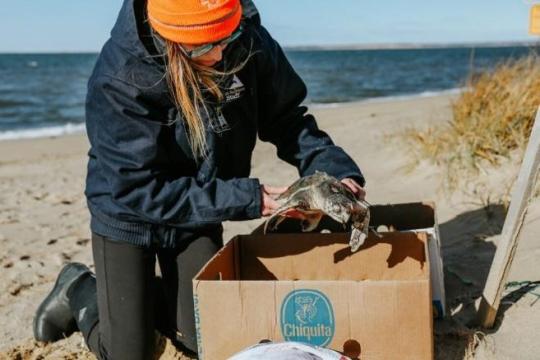 A responder rescues a cold-stunned sea turtle from a Cape Cod beach. Photo courtesy of Mass Audubon Wellfleet Bay.
A responder rescues a cold-stunned sea turtle from a Cape Cod beach. Photo courtesy of Mass Audubon Wellfleet Bay.
Massachusetts Cold-stunned Sea Turtles: A Sign of Climate Change?
Management Overview
The Kemp's ridley turtle is listed as endangered under the Endangered Species Act.
Additionally, the Kemp's ridley turtle is listed under:
- Appendix I of the Convention on International Trade in Endangered Species of Wild Fauna and Flora (CITES)
Annex II of the Protocol for Specially Protected Areas and Wildlife (SPAW)
In the United States, NOAA Fisheries and the U.S. Fish and Wildlife Service have joint jurisdiction for sea turtles, with NOAA having the lead in the marine environment and U.S. FWS having the lead on the nesting beaches. Both federal agencies, along with many state, and U.S. territory agencies and international partners, are working together to conserve and recover sea turtles and have issued regulations to eliminate or reduce threats to sea turtles.
Recovery Planning and Implementation
Recovery Action
To help identify and guide the protection, conservation, and recovery of sea turtles, the ESA requires NOAA Fisheries and the U.S. FWS to develop and implement recovery plans which provide a blueprint for conservation of the species and measurable criteria to gauge progress toward recovery.
The major recovery actions for Kemp’s ridley turtles include:
- Protecting sea turtles on nesting beaches and in marine environments
- Protecting nesting and foraging habitats
- Reducing bycatch in commercial, artisanal, and recreational fisheries
- Reducing the effects of entanglement and ingestion of marine debris
- Reducing vessel strikes in coastal habitats
- Working with partners internationally to protect turtles in all life-stages
- Supporting research and conservation projects consistent with Recovery Plan priorities
In 1991, a recovery plan was developed to recover and protect the Kemp’s ridley turtle population in the U.S. Caribbean, Atlantic Ocean, and Gulf of America (formerly Gulf of Mexico). In 2011, a bi-national recovery plan for the Kemp’s ridley sea turtle was developed in conjunction with the Secretary of Environment and Natural Resources, Mexico (SEMARNAT). The recovery team made additional recommendations in 2014.
The highly migratory behavior of sea turtles makes them shared resources among many nations, so conservation efforts for sea turtle populations must extend beyond national boundaries. This necessitates international collaboration and coordination. Learn more about international conservation efforts below.
Implementation
NOAA Fisheries is working to minimize effects from human activities that are detrimental to the recovery of Kemp’s ridley turtles in the United States and internationally. Together with our partners, we undertake numerous activities to support the goals of the Kemp’s ridley turtle recovery plan, with the ultimate goal of species recovery.
Efforts to conserve Kemp’s ridley turtles include:
- Protecting habitat
- Reducing bycatch
- Rescue, disentanglement, and rehabilitation
- Eliminating the killing of turtles and the collection of their eggs
- Eliminating the harassment of turtles on nesting beaches and foraging habitats through education and enforcement
- Consulting with federal agencies to ensure their activities are not likely to jeopardize the continued existence of listed species

Critical Habitat
Once a species is listed under the ESA, NOAA Fisheries evaluates and identifies whether any marine areas meet the definition of critical habitat. Those areas may be designated as critical habitat through a rulemaking process. A critical habitat designation does not set up a marine preserve or refuge. Rather, federal agencies that undertake, fund, or permit activities that may affect designated critical habitat areas are required to consult with NOAA Fisheries to ensure that their actions do not adversely modify or destroy these designated critical habitats.
In 2010, NOAA Fisheries and the U.S. FWS were jointly petitioned to designate critical habitat pursuant to the discretion that exists for the agency to determine whether to designate critical habitat for species listed prior to 1978.
Conservation Efforts
Reducing Bycatch
NOAA Fisheries is working to reduce the bycatch of sea turtles in commercial and artisanal fisheries. Our efforts are focused on documenting bycatch, understanding how, why, and where sea turtles are bycaught, and how to reduce that bycatch. We work with partners and industry to develop modifications to fishing gear and practices to reduce bycatch and/or reduce bycatch injuries. These modifications are required in certain U.S. commercial fisheries including gillnets, longlines, pound nets, scallop dredges, and trawls that unintentionally capture sea turtles. Measures include:
- Gear modifications
- Changes to fishing practices
- Time/area closures
In the United States, NOAA Fisheries has worked closely with the shrimp trawl fishing industry to develop Turtle Excluder Devices (TEDs) to reduce the mortality of sea turtles bycatch in shrimp trawls. TEDs are required in the shrimp otter trawl fishery and, in early 2021, in larger vessels participating in the skimmer trawl fishery.
Since 1989, the U.S. has prohibited the importation of shrimp harvested in a manner that adversely affects sea turtles. The import ban does not apply to nations that have adopted sea turtle protection programs comparable to that of the United States (i.e., require and enforce the use of TEDs) or to nations where bycatch in shrimp fisheries does not present a threat to sea turtles (for example, nations that fish for shrimp in areas where sea turtles do not occur). The U.S. Department of State is the principal implementing agency of this law while NOAA Fisheries serves as technical advisors and provides extensive TED training throughout the world.
We are also involved in cooperative gear research projects, implementation of changes to gear and fishing practices, and safe handling protocols designed to reduce sea turtle bycatch in the Gulf of America and Atlantic pelagic longline fisheries, the Atlantic sea scallop dredge fishery, the Virginia Chesapeake Bay pound net fishery, mid-Atlantic gillnet fishery, and non-shrimp trawl fisheries in the Atlantic and Gulf of America.
Fisheries Observers
Bycatch in fishing gear is the primary human-caused source of sea turtle injury and mortality in U.S. waters. The most effective way to learn about bycatch is to place observers aboard fishing vessels. Observers collect important information that allows us to understand the amount and extent of bycatch, how turtles interact with the gear, and how bycatch reduction measures are working.
NOAA Fisheries determines which fisheries are required to carry observers, if requested to do so, through an annual determination. Observers may also be placed on fishing vessels through our authorities under the Magnuson-Stevens Act.
Responding to Strandings and Entanglements
A stranded sea turtle is one that is found on land or in the water and is either dead or is alive but unable to undergo normal activities and behaviors due to an injury, illness, or other problem. Most strandings are of individual turtles, and thousands are documented annually along the coasts of the United States and its territories. Organized networks of trained stranding responders are authorized to recover dead turtles or assist live turtles and document important information about the causes of strandings. These networks include federal, state, and private organizations. The actions taken by stranding network participants improve the survival of sick, injured, and entangled turtles while also helping scientists and managers expand their knowledge about threats to sea turtles and causes of mortality.
Because sea turtles spend most of their life at sea and out of sight, information learned from strandings are an important way for us to identify and monitor problems that threaten sea turtle populations.
Within the United States and its territories, there are three regional networks that serve to document and rescue stranded and entangled sea turtles:
- Atlantic Ocean, Gulf of America, and Caribbean: Coordinated under the Sea Turtle Stranding and Salvage Network (STSSN)
- Pacific Ocean (continental U.S. West Coast): Coordinated by NOAA’s West Coast Regional Office
- Pacific Islands (Hawaii, American Samoa, Guam, and the Commonwealth of the Northern Mariana Islands): Coordinated by NOAA’s Pacific Islands Fisheries Science Center and the Pacific Islands Regional Office
Periodically mass strandings of sea turtles, especially Kemp’s ridley and green turtles, occur in specific areas of the Atlantic and Gulf of America coasts when water temperatures drop suddenly in shallow, inshore areas where turtles are present (i.e., cold stunning events). During these events, hundreds or even thousands of turtles may require rescue and care.
International Conservation Efforts
The conservation and recovery of sea turtles requires international cooperation and agreements to ensure the survival of these highly migratory animals. We work closely with partners in many countries across the globe to promote sea turtle conservation and recovery. Two international agreements specifically focused on sea turtle conservation are:
Additional international treaties and agreements that also protect sea turtles include:
- Convention on International Trade in Endangered Species (CITES): Listed in Appendix I, which prohibits international trade of wild flora and fauna
- Cartagena Convention: Protected under Annex II of the Specially Protected Areas and Wildlife (SPAW) Protocol
The Mexican government has played a vital role in the conservation of the Kemp's ridley sea turtle. The Kemp's ridley turtle has benefited from legal protection by Mexico since the 1960s. In 1977, a refuge was established at the only known nesting beach and included the Rancho Nuevo nesting beach as part of a system of reserves for sea turtles. In 1990, a complete ban on taking any species of sea turtle was implemented by the Mexican government. In 2002, the beach at Rancho Nuevo was designated as a Natural Protected Area under the category of Sanctuary.
Regulatory History
The Kemp’s ridley sea turtle was listed as endangered throughout its range on December 2, 1970 and has received Federal protection under the Endangered Species Act since that time.
In 1992, we finalized regulations to require turtle excluder devices (TEDs) in shrimp trawl fisheries to reduce sea turtle bycatch. Since then, we have updated these regulations as new information became available and TEDs were modified to improve their turtle exclusion rates.
We have also implemented other measures to reduce sea turtle bycatch in fisheries through regulations and permits under both the ESA and Magnuson-Stevens Act. These requirements include the use of large circle hooks in longline fisheries, time and area closures/mesh size restrictions for gillnets, and modifications to Virginia pound net leaders and Atlantic scallop dredges.
Key Actions and Documents
Incidental Take Permit to North Carolina Division of Marine Fisheries (Sea Turtles and Sturgeon)
- Notice; Issuance of Permit (89 FR 82573, 10/11/2024)
- Notice of Availability - Draft Environmental Assessment (88 FR 54303, 08/10/202…
- Correction to Receipt of Application (88 FR 859, 01/05/2023)
- Receipt of application (87 FR 78659, 12/22/2022)
Incidental Take Permit to Barney Davis, LLC.
- Notice of issuance (85 FR 48508)
- Receipt of revised application and request for comments (84 FR 51116)
- Receipt of application (82 FR 43224)
Incidental Take Permit to North Carolina Division of Marine Fisheries for Sea Turtles
- Issuance of permit
- Notice of availability (environmental assessment)
- Receipt of application
- Receipt of application
Last updated by NOAA Fisheries on 05/29/2025
Science Overview
NOAA Fisheries conducts research on the biology, behavior, and ecology of the Kemp’s ridley sea turtle. The results of this research are used to inform management decisions and enhance recovery efforts for the species.
Population Assessments
Sea turtle population assessments include information on species’ abundance and distribution, life history, and human impacts. This information can help NOAA Fisheries evaluate the effectiveness of conservation and recovery measures, and can help guide actions to enhance recovery. To estimate population abundance, researchers conduct aerial and vessel-based surveys of selected areas and capture and mark turtles in the water and on beaches. We also incorporate data collected on nesting beaches, via stranding networks and from fisheries observer programs. Other information that informs sea turtle population assessments includes population structure (genetic analyses), age to maturity, survivorship of the various life stages (e.g., hatchling, juvenile, adult), foraging and reproductive behavior, movement and distribution, and habitat studies.
Tagging and Tracking Studies
Satellite telemetry allows researchers to track sea turtles as they migrate between and within foraging and nesting areas. Tags are designed and attached in a manner that minimizes disturbance and/or harm to the turtle. The data help us understand migration patterns, identify feeding areas, and identify where turtles overlap with their primary threats (e.g., fisheries, vessel traffic).
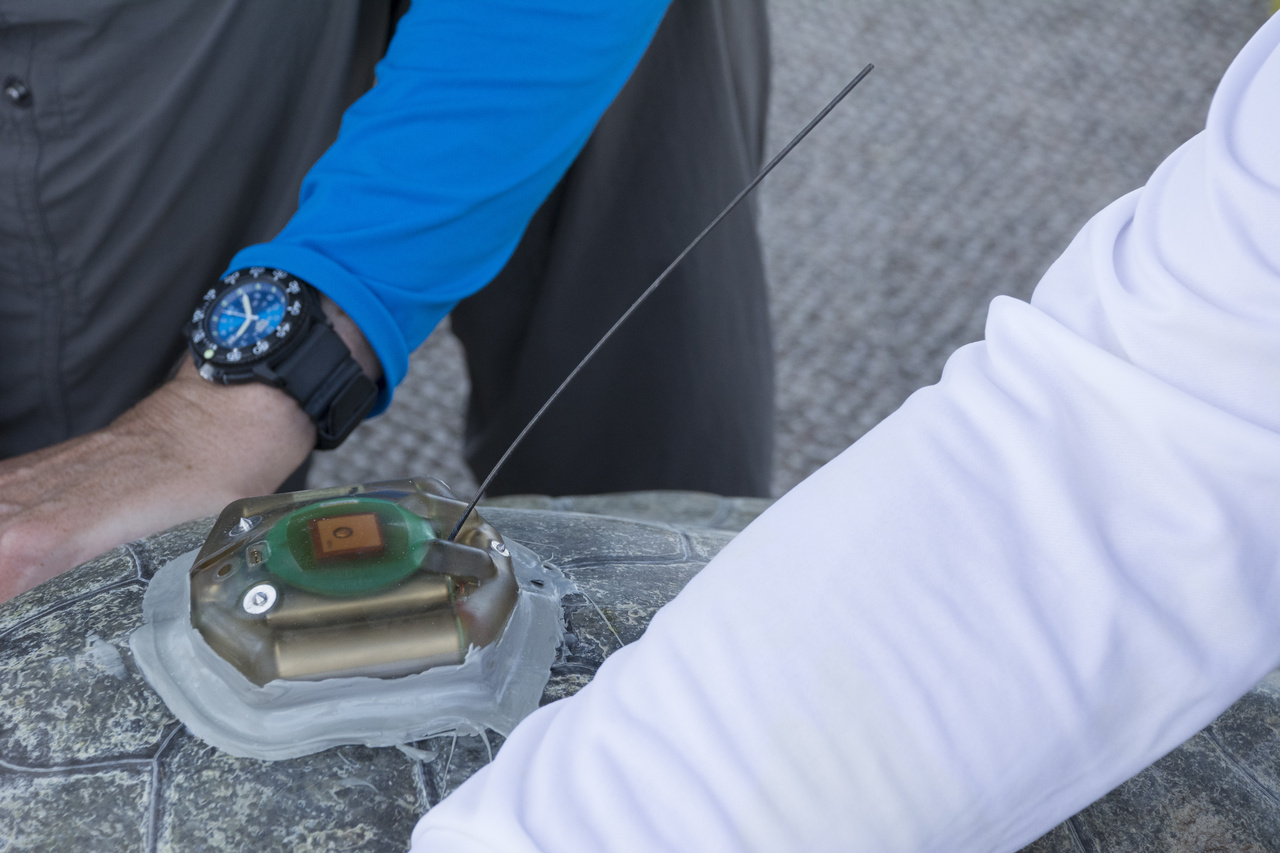
Kemp's ridley sea turtle with satellite tag curing to shell. The epoxy takes two hours to cure, so this animal is resting onboard the small research boat prior to being released. Photo: Paul B. Hillman.
Research to Reduce Bycatch in Fishing Gear
We observe fisheries to understand the level of sea turtle bycatch and the ways in which turtles interact with fishing gear. We work with partners and industry to develop modifications to fishing gear and/or fishing practices to reduce sea turtle bycatch while at the same time retaining a sustainable catch of targeted species. These efforts include the development of Turtle Excluder Devices (TEDs) for use in trawl fisheries, use of circle hooks and certain bait types in longline fisheries, time and area closures/mesh size restrictions and low profile designs for gillnets, and modifications to Virginia pound net leaders and Atlantic scallop dredge gear.
Learn more about our fishing gear research
Sea Turtle Genetics
NOAA Fisheries’ National Sea Turtle Molecular Genetics Center serves as a worldwide central repository for sea turtle tissue and DNA samples and constitutes a major area of research supporting sea turtle conservation. For example, a turtle’s genetic “fingerprint” can be used to determine which nesting population it originated from.
Learn more about our turtle genetics and isotope studies
Life History Studies
Life history studies include gathering information on such things as migration patterns, where turtles nest and forage, growth rates, age to maturity, and sex ratios. This information is important in understanding key biological parameters that influence population trends and inform the conservation status.
Last updated by NOAA Fisheries on 05/29/2025
Documents
Northern Gulf of Mexico Sea Turtle Strandings: A Summary of Findings and Analyses from 2015–2019
The Technical Memo presents information, analyses, and conclusions related to the study of sea…
Biological Opinion on the Federally Regulated Oil and Gas Program Activities in the Gulf of Mexico
Programmatic biological opinion on the Gulf of Mexico oil and Gas Program in federal waters…
Integrated Bayesian models to estimate bycatch of sea turtles in the Gulf of Mexico and southeastern U.S. Atlantic coast shrimp otter trawl fishery
Elizabeth A. Babcock, Michael Barnette, James Bohnsack, John Jeffery Isely, Clay Porch, Paul M…
Kemp’s Ridley Sea Turtle (Lepidochelys Kempii) 5-Year Review: Summary and Evaluation
This document is the ESA 5-year review of the species based on the best available data.
Data & Maps
Recovery Action Database
Tracks the implementation of recovery actions from Endangered Species Act (ESA) recovery plans.
Research
Regional Variation in Kemp’s Ridley Sea Turtle Diet Composition and its Potential Relationship with Somatic Growth
Understanding the relationship between sea turtle foraging ecology and somatic growth dynamics.
Outreach & Education
Protected Marine Species Identification Guide Southeast United States
This guide is intended for use by mariners in the identification and reporting of threatened and…
Last updated by NOAA Fisheries on 05/29/2025
